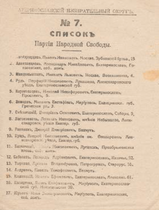Yekaterinoslav electoral district (Russian Constituent Assembly election, 1917)
| Yekaterinoslav | |
|---|---|
| Former Civilian constituency for the All-Russian Constituent Assembly | |
 | |
| Former constituency | |
| Created | 1917 |
| Abolished | 1918 |
| Number of members | 18 |
| Number of Uyezd Electoral Commissions | 8 |
| Number of Urban Electoral Commissions | 5 |
| Number of Parishes | 238 |
| Sources: | [1][2] |
The Yekaterinoslav electoral district (Russian: Екатеринославский избирательный округ) was a constituency created for the 1917 Russian Constituent Assembly election.
The electoral district covered the Yekaterinoslav Governorate.[3] Yekaterinoslav was a large province; ethnically and economically diverse.[4] The Yekaterinoslav electoral district recorded the highest vote for a landowners list in the country. List 1, Landowners and Nonpartisan Progressives, gathered 26,597 votes (2.2%), and was headed by Mikhail Rodzianko (an Octobrist leader, having served as the presiding officer in the 3rd and 4th Dumas, elected on the Stolypin franchise).[5] Joseph Stalin stood as a candidate on the Bolshevik list.[6] The conservative press reported a quiet and orderly election in the province.[7]
Out of the ten deputies elected from List 5, nine belonged to the Ukrainian Socialist-Revolutionary Party and one belonged to the Ukrainian Social Democratic Labour Party.[8]
Results
[edit]
|
|
In Yekaterinoslav town the Bolshevik list won the election, obtaining 20,849 votes (26.4%), followed by the Jewish National Electoral Committee 14,521 votes (18.3%), the Ukrainian socialist bloc 12,950 votes (16.4%), Kadets 9,224 votes (11.7%), SRs 6,627 votes (8.4%), Mensheviks 4,601 votes (5.8%), Landowners 3,608 votes (4.5%), the United Jewish Socialist Labour Party 1,781 votes (2.3%), Bund 1,545 votes (1.9%), Cooperative-Popular Socialists 1,007 votes (1.3%), Poalei-Zion 624 votes (0.8%), Unity 607 votes (0.8%), Germans 533 votes (0.7%), Orthodox-Farmers list 531 votes (0.7%) and Greeks 43 votes.[8] The Ukrainian list dominated the vote in the Yekaterinoslav garrison, obtaining 3,770 votes (41.9%), followed by the Bolsheviks with 1,756 votes (19.5%), SRs 1,415 votes (15.7%), Jewish National Electoral Committee 720 votes (8%), Landowners 461 votes (5.1%), Kadets 301 votes (3.3%), Mensheviks 286 votes (3.2%), Popular Socialists-Cooperative 100 votes (1.1%), Unity 59 votes (0.7%), United Jewish Socialist Labour Party 56 votes (0.7%), Germans 49 votes (0.5%) and Orthodox-Farmer list 33 votes (0.4%).[8]
Ballots
[edit]-
List 6 - Orthodox-Farmers
-
List 7 - Kadets
-
List 8 - Jewish Social Democratic Labour Party (Poalei Zion)
-
List 9 - Russian Social Democratic Labour Party (Bolsheviks-Internationalists) and the Bakhmut Soviet of Peasants Deputies
-
List 10 - Jewish National Electoral Committee
-
List 11 - Bund
-
List 12 - Mensheviks
-
List 13 - Greek settlement of Mariupol uezd
References
[edit]- ^ И. С. Малчевский (1930). Всероссийское учредительное собрание. Гос изд-во. pp. 140–142.
- ^ Б. Ф Додонов; Е. Д Гринько; О. В.. Лавинская (2004). Журналы заседаний Временного правительства: Сентябрь-октябрь 1917 года. РОССПЭН. pp. 206–208. ISBN 9785824302035.
- ^ Татьяна Евгеньевна Новицкая (1991). Учредительное собрание: Россия 1918 : стенограмма и другие документы. Недра. p. 13.
- ^ Oliver Henry Radkey (1989). Russia goes to the polls: the election to the all-Russian Constituent Assembly, 1917. Cornell University Press. p. 93. ISBN 978-0-8014-2360-4.
- ^ Oliver Henry Radkey (1989). Russia goes to the polls: the election to the all-Russian Constituent Assembly, 1917. Cornell University Press. p. 111. ISBN 978-0-8014-2360-4.
- ^ Joseph Stalin (1953). 1917, March-October. Foreign Languages Publishing House. p. 449.
- ^ Oliver Henry Radkey (1989). Russia goes to the polls: the election to the all-Russian Constituent Assembly, 1917. Cornell University Press. pp. 48–49. ISBN 978-0-8014-2360-4.
- ^ a b c d Л. М Спирин (1987). Россия 1917 год: из истории борьбы политических партий. Мысль. pp. 273–328.
- ^ Oliver Henry Radkey (1989). Russia goes to the polls: the election to the all-Russian Constituent Assembly, 1917. Cornell University Press. pp. 148–160. ISBN 978-0-8014-2360-4.
- ^ Лев Григорьевич Протасов (2008). Люди Учредительного собрания: портрет в интерьере эпохи. РОССПЭН. ISBN 978-5-8243-0972-0.









